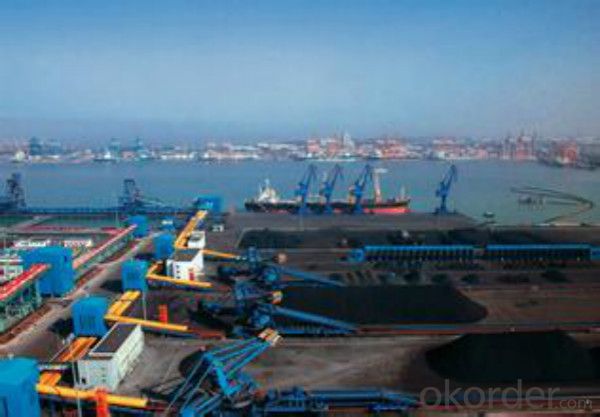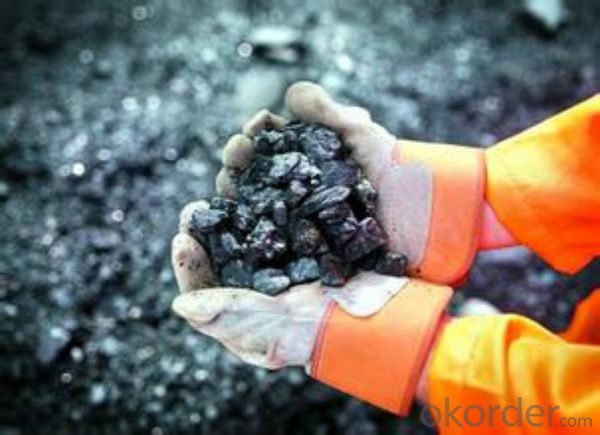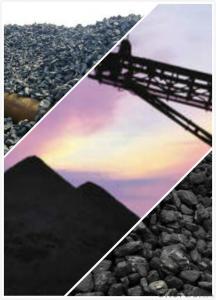150-180mmFoundry Coke Manufactured in China in High Quality
- Loading Port:
- Tianjin
- Payment Terms:
- TT OR LC
- Min Order Qty:
- 800 m.t
- Supply Capability:
- 20000 m.t/month
OKorder Service Pledge
OKorder Financial Service
You Might Also Like
Product Description
Foundry Coke is a kind of main raw materials used for steel making, we have own coke plants at Shanxi province with output 2 million MT.The coke is made from superior coking coal of Shanxi province. Provided with the dvantages of low ash, low sulphur and high carbon.Our coke is well sold in European,American,Japanese and South-east Asian markets.
Features
This is a special coke that is used in furnaces to produce cast and ductile iron products. It is a source of heat and also helps maintain the required carbon content of the metal product. Foundry coke production requires lower temperatures and longer times than blast furnace coke.
Specification
Fixed Carbon | Sulphur Content | Moisture | V.Matter | Ash |
86%min | 0.7%max | 5%max | 1.2%max | 12%max |
88%min | 0.65%max | 5%max | 1.5%max | 10%max |
85%min | 0.8%max | 15%max | 2%max | 13.5%max |
Pictures


FAQ:
1 How long can we deliver the cargo?
Within 30 days after receiving the LC draft or down payment
2 Time for after-sales?
1 year.
3 Cutomized or general specfications?
Both
- Q:How does carbon contribute to the strength of concrete?
- Carbon can contribute to the strength of concrete in several ways. One of the primary ways is through the use of carbon nanotubes (CNTs) or carbon fibers. These materials are added to the concrete mixture, acting as reinforcement and enhancing its mechanical properties. When CNTs or carbon fibers are incorporated into the concrete, they create a network of small, strong, and lightweight particles. This network helps to improve the overall strength and durability of the concrete, making it more resistant to cracking, flexing, and other forms of structural damage. Additionally, the carbon particles also enhance the bonding between the cement paste and the aggregates in the concrete. This improved bonding increases the interfacial strength, resulting in a stronger and more cohesive concrete matrix. Furthermore, carbon can also contribute to the strength of concrete by acting as a pozzolan. Pozzolans are materials that react chemically with calcium hydroxide, a byproduct of cement hydration, to form additional cementitious compounds. These compounds fill in the gaps between cement particles, resulting in a denser and stronger concrete structure. Carbon black, a type of finely divided carbon, is commonly used as a pozzolan in concrete mixes. Overall, the incorporation of carbon in concrete, whether through carbon nanotubes, carbon fibers, or as a pozzolan, can significantly enhance its strength and performance. By reinforcing the concrete matrix, improving bonding, and filling in gaps, carbon helps to create a more durable and robust material suitable for various construction applications.
- Q:How much is a ton of carbon fiber? How much difference is made between domestic and imported?
- Industrial grade carbon fiber, ranging in price from 160 thousand to 290 thousand.
- Q:What are carbon nanomaterials?
- Carbon nanomaterials are a class of materials that are composed of carbon atoms arranged in various structures at the nanoscale. These structures can include carbon nanotubes, fullerenes, and graphene. Carbon nanotubes are cylindrical structures made up of rolled-up sheets of graphene, while fullerenes are closed-cage molecules consisting of carbon atoms. Graphene, on the other hand, is a single layer of carbon atoms arranged in a hexagonal lattice. Carbon nanomaterials possess unique properties that make them highly desirable for a wide range of applications. They exhibit exceptional mechanical strength, high electrical and thermal conductivity, as well as excellent chemical stability. These properties arise from the strong covalent bonds between carbon atoms and the unique arrangements of these atoms in the nanoscale structures. Due to their remarkable characteristics, carbon nanomaterials have found numerous applications in various fields. They are used in electronics and computing devices, where their high electrical conductivity and small size make them ideal for creating faster, smaller, and more efficient components. Carbon nanotubes have also been utilized in composite materials to enhance their mechanical strength and durability. Furthermore, carbon nanomaterials have shown promise in the field of medicine and healthcare. They can be used for drug delivery systems, where they can encapsulate and transport drugs to specific targets in the body. Carbon nanomaterials have also been investigated for their antibacterial properties, making them potential candidates for developing antimicrobial coatings and surfaces. Overall, carbon nanomaterials are a diverse class of materials with exceptional properties that have led to numerous exciting applications in various industries. As research continues, their potential uses are likely to expand, revolutionizing fields such as electronics, medicine, and materials science.
- Q:What are the impacts of carbon emissions on the stability of mountains?
- Carbon emissions have significant impacts on the stability of mountains. One of the most prominent impacts is the acceleration of global warming, which leads to the melting of glaciers and permafrost. As mountains are home to many glaciers, the increase in temperature causes these glaciers to melt at an alarming rate. This melting can result in the destabilization of mountains, leading to increased landslide and rockfall activity. Furthermore, carbon emissions contribute to the acidification of rainwater. Acid rain can erode the rocks and soil in mountains, weakening their stability. This erosion can lead to slope instability, making mountains more susceptible to landslides and other forms of mass movements. Additionally, carbon emissions contribute to changes in precipitation patterns. Mountain ecosystems heavily rely on a delicate balance of rainfall and snowfall. However, climate change caused by carbon emissions disrupts this balance, leading to altered precipitation patterns. This can result in increased water runoff and a reduction in snowpack, both of which contribute to mountain destabilization. Moreover, carbon emissions have indirect impacts on mountain stability through changes in vegetation patterns. As temperatures rise, plant species may migrate to higher altitudes in search of cooler climates. This can result in the loss of vegetation in lower elevation areas, which play a crucial role in stabilizing slopes and preventing erosion. The absence of plant cover leads to increased soil erosion, leaving mountains more vulnerable to landslides and other erosive processes. In conclusion, carbon emissions have detrimental impacts on the stability of mountains. The acceleration of global warming, acidification of rainwater, altered precipitation patterns, and changes in vegetation patterns all contribute to the destabilization of mountains. It is crucial to reduce carbon emissions and mitigate climate change to protect and preserve these majestic natural formations.
- Q:What is a carbon free martensite?
- The definition of martensite of Fe based alloy (solid steel and other iron-based alloy) and non ferrous metals and alloys, is guetche variant diffusion free phase transition product of martensitic transformation. It is a product of Fe based alloy, phase transformation of undercooled austenite occurs without diffusion were guetche formation of martensite variant body transformation.
- Q:How does carbon impact the availability of clean energy solutions?
- Carbon has a significant impact on the availability of clean energy solutions. Carbon emissions from burning fossil fuels and other human activities are the main contributor to climate change, which poses a serious threat to the environment and human well-being. As a result, there is an urgent need to transition to cleaner energy sources that produce lower carbon emissions. Clean energy solutions, such as renewable energy technologies like solar and wind power, have the potential to reduce carbon emissions significantly. These sources of energy generate electricity without burning fossil fuels, thus producing little to no carbon emissions. By replacing traditional energy sources with clean ones, we can reduce our carbon footprint and mitigate climate change. However, the availability and scalability of clean energy solutions are impacted by carbon emissions in several ways. First, the continued reliance on carbon-intensive energy sources, such as coal and oil, hinders the rapid adoption of clean energy technologies. The infrastructure and investments in fossil fuel-based energy systems make it challenging to shift towards clean alternatives. Secondly, carbon emissions contribute to global warming, which affects the availability and efficiency of certain clean energy solutions. For example, rising temperatures can reduce the efficiency of solar panels and impact the output of hydropower due to changing rainfall patterns. This highlights the importance of mitigating carbon emissions to ensure the long-term viability and effectiveness of clean energy technologies. Furthermore, carbon emissions have economic implications that can impact the availability of clean energy solutions. Governments and policymakers play a crucial role in incentivizing the adoption of clean energy through regulations, subsidies, and carbon pricing mechanisms. These policies can influence the affordability and accessibility of clean energy technologies, making them more attractive to investors and consumers. In conclusion, carbon emissions have a profound impact on the availability of clean energy solutions. By reducing carbon emissions and transitioning to cleaner energy sources, we can mitigate climate change, improve the efficiency of clean energy technologies, and create a more sustainable future. It is essential for governments, businesses, and individuals to prioritize the development and adoption of clean energy solutions to ensure a cleaner and healthier planet for future generations.
- Q:What are greenhouse gases?
- Greenhouse gases are gases that trap heat in the Earth's atmosphere, contributing to the greenhouse effect. They include carbon dioxide (CO2), methane (CH4), nitrous oxide (N2O), and fluorinated gases. These gases are naturally occurring and are also emitted through human activities such as burning fossil fuels, deforestation, and industrial processes. The greenhouse effect is vital for life on Earth as it helps to keep the planet warm enough to support life. However, excessive emissions of greenhouse gases have caused an imbalance in the atmosphere, leading to global warming and climate change. It is important to reduce greenhouse gas emissions and find sustainable alternatives to mitigate the impacts of these gases on our planet.
- Q:Carbon steel with carbon steel, carbon steel yuan yuan is the same? The trouble to know the answer urgently
- For Fang Gang, bar, angle steel, steel, steel wire and other types. According to the shape of carbon structure round is carbon steel round. Especially carbon steel is often said in the past round. Such as 45# round steel. Carbon steel and carbon circle is not necessarily a variety.
- Q:Carbon injection molding machine heating several degrees
- The nozzle temperature is 260~310 degrees, and the temperature control of the two types of injection molding machine nozzles is different. The mold temperature has great influence on the mechanical properties of the products. With the increase of mold temperature. The temperature and the temperature difference between the temperature decreases, the shear stress decreases, can melt in the mold cavity slow cooling, the molecular chain orientation to relaxation reduced, thereby reducing the internal stress of products, but the impact strength and elongation of the products decreased significantly, while there will be demolding. When demoulding, it is easy to deform, prolong the molding cycle and reduce the production efficiency, while the lower mold temperature will increase the internal stress of the product. Therefore, the die temperature must be controlled. Normally, the mold temperature of PC is 80~120 degrees centigrade. Ordinary products are controlled at 80~100 degrees, while for complex shapes, thin walls and high requirements, the product is controlled at 100~120 degrees centigrade and is not allowed to exceed its thermal deformation temperature. Mold temperature control is particularly important when forming PC thick wall products.
- Q:How does carbon affect ocean acidification?
- Various human activities, such as burning fossil fuels and deforestation, release carbon dioxide (CO2) into the atmosphere. This CO2 is a greenhouse gas that, when absorbed by the oceans, leads to a process called ocean acidification. When CO2 dissolves in seawater, it reacts with water molecules and forms carbonic acid. This reaction increases the concentration of hydrogen ions (H+), resulting in a decrease in pH levels and making the seawater more acidic. This decrease in pH is a key characteristic of ocean acidification. As the ocean becomes more acidic, it disrupts the delicate chemical balance that many marine organisms rely on for survival and growth. Organisms like corals, shellfish, and phytoplankton use calcium carbonate to build their shells or skeletons, but increased acidity hampers their ability to do so. Ocean acidification also impacts the growth and development of marine plants and animals. For instance, changes in pH levels can affect the ability of larvae from certain marine species to form strong shells or skeletons. Additionally, acidified waters can disrupt the metabolism and reproductive processes of many marine organisms. The consequences of ocean acidification extend beyond individual organisms. Entire ecosystems, such as coral reefs, face threats due to increasing acidity. Coral reefs provide habitat for numerous species and are vital to marine biodiversity. However, the more acidic conditions make it challenging for corals to build and maintain their calcium carbonate structures, resulting in coral bleaching and degradation of reef systems. Moreover, ocean acidification can have cascading effects on other marine organisms and food webs. For example, changes in the growth and survival rates of phytoplankton, a primary food source for many marine species, can disrupt the entire food chain, impacting fish populations and ultimately affecting human communities that rely on seafood for sustenance and livelihoods. In conclusion, the rise in carbon dioxide emissions contributes to ocean acidification, which alters the chemistry of the oceans and poses significant threats to marine life and ecosystems. Understanding and addressing the causes and impacts of ocean acidification are essential for the long-term health and sustainability of our oceans.
1. Manufacturer Overview |
|
|---|---|
| Location | |
| Year Established | |
| Annual Output Value | |
| Main Markets | |
| Company Certifications | |
2. Manufacturer Certificates |
|
|---|---|
| a) Certification Name | |
| Range | |
| Reference | |
| Validity Period | |
3. Manufacturer Capability |
|
|---|---|
| a)Trade Capacity | |
| Nearest Port | |
| Export Percentage | |
| No.of Employees in Trade Department | |
| Language Spoken: | |
| b)Factory Information | |
| Factory Size: | |
| No. of Production Lines | |
| Contract Manufacturing | |
| Product Price Range | |
Send your message to us
150-180mmFoundry Coke Manufactured in China in High Quality
- Loading Port:
- Tianjin
- Payment Terms:
- TT OR LC
- Min Order Qty:
- 800 m.t
- Supply Capability:
- 20000 m.t/month
OKorder Service Pledge
OKorder Financial Service
Similar products
New products
Hot products





























